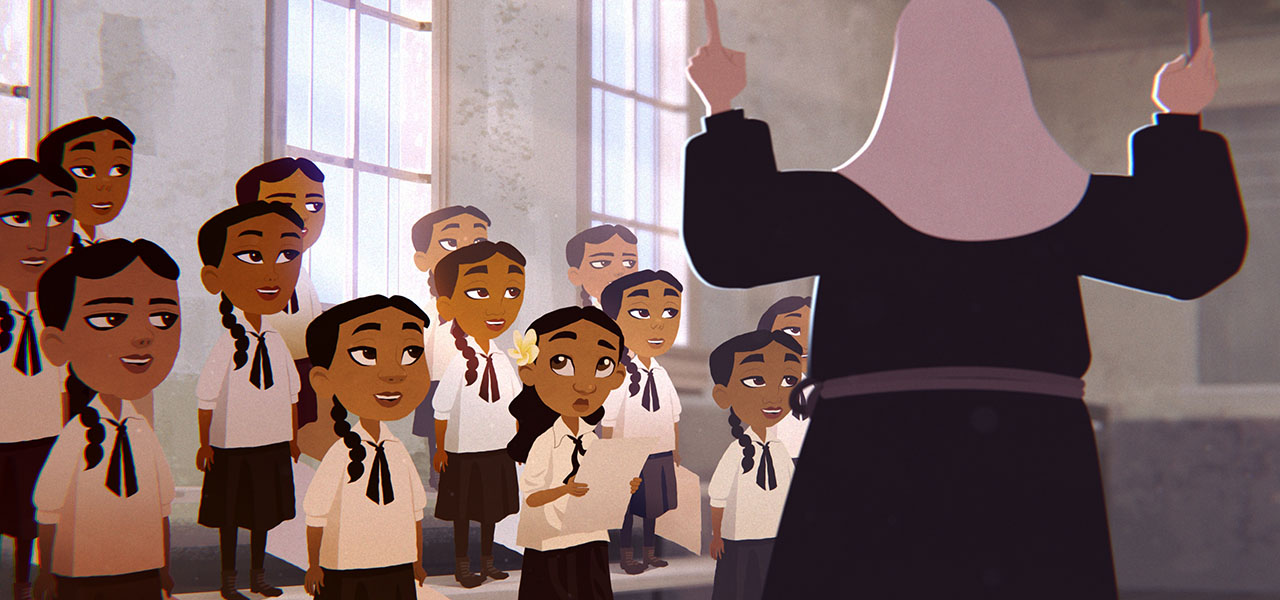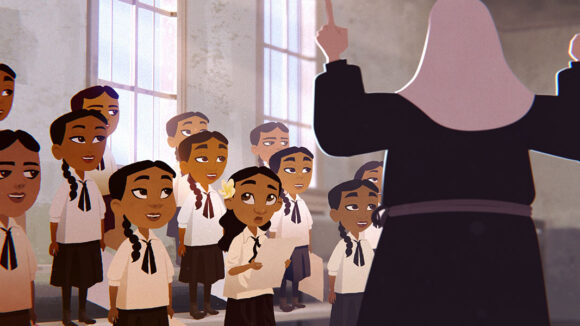

2025 Oscars Short Film Contenders: ‘The Queen’s Flowers’ Director Ciara Lacy
Cartoon Brew is putting the spotlight on animated short films that have qualified for the 2025 Oscars.
Today’s film is The Queen’s Flowers from Hawaiian filmmaker Ciara Lacy. The short earned its Oscars qualification by winning the Made In Hawaii Short Film award at the Hawaii International Film Festival.
As a magical take on a true story, The Queen’s Flowers is a vibrant animated short adventure aimed at children’s audiences that follows Emma, a Native Hawaiian girl in 1915 Honolulu. Weaving a very special gift for the last monarch of Hawaii Queen Lili’uokalani, Emma mirrors director Ciara Lacy’s and Oscar-nominated animation director Daniel Sousa’s will to tell a modern story that will resonate with Hawaiian and international audiences alike. The film is produced by Ocean in a Drop Productions, co-produced with Qwaves and Strongman.
Cartoon Brew: Beyond the story of indigenous girl empowerment, the short also brings forth the doom of Hawaiian independence at the hands of U.S. colonists. How did you feel about pushing this angle forward, especially through a children’s story, and how has that resonated with the international audience?

Ciara Lacy: The film has screened at festivals around the world, even winning jury and audience awards in Singapore and Wales. So while we were initially uncertain about its reception, we have witnessed its impact on other people and cultures. Telling the story of Hawaii’s theft of governance, and later independence, is not only appropriate but necessary. Children’s tales approach all kinds of subject matter, from the lighthearted to the gut-wrenching, to help guide their perspective on the world.
The loss of national independence came at the hands of Americans – in 1898. So in that case, the key terminology is “American” – as a nation, and “Hawaiian” as a nation. I think this injustice from the American government – in the midst of fighting a war [Spanish-American War and the Philippine-American War] resonates more and more every day in current times as the world is reassessing its understanding of the position of the U.S. in international affairs. While we almost exclusively tend to focus on the events as “doom” – and therefore make the American bad guy the central character in the recounting of the overthrow of the Hawaiian Nation, the story is being used more and more as a story of Native Hawaiian resilience, determination, and presence on the landscape. Native Hawaiians are here, present, and accomplishing incredible things today. And despite the loss of our nationhood, the fact that our ancestors continued to fight no matter the circumstances inspires hope and gratitude in many Native Hawaiians and others of today.
What was it about this story or concept that connected with you and compelled you to direct the film?
As a little girl in Hawaii, I spent many cool mornings picking blossoms of jasmine or crown flowers amongst the butterflies and bees. I would then sit under the shade of the mango tree, amongst my family, with a needle and thread, stitching thick ropes of fragrant color known as lei that we would sell to vendors at the airport or Chinatown. Lei-making was a tradition that I knew intimately, a business that supported our family as Native Hawaiians, so when producer Concepcion Saucedo-Trejo shared a true story from 1915 about a little girl named Emma Pollock who loved to gift lei to the last Queen of Hawaii, it immediately felt like destiny. I felt like I knew Emma.
As we began the process of collaborating with director of animation Daniel Sousa, I immediately knew I wanted the film to be filled with visual ‘kaona’ or layers of meaning. Every scene was not only painstakingly built off of historical reference images — we sourced hundreds of drawings and photos from multiple archives — it was also carefully encoded with symbols and gestures rich with meaning in Hawaiian culture. The opportunity to imbue the film with these types of cultural details and practices excited me to no end. Mixed with staple elements of fantasy, the goal was to make the work not only culturally specific but somehow also broadly accessible. In turn, my hope is that the first viewing of the film offers a feast for the eyes, and on subsequent viewings there are new details to discover and marvel over.
What did you learn through the experience of making this film, either production-wise, filmmaking-wise, creatively, or about the subject matter?
Crafting this film was the chance to connect with an incredible woman, the last reigning monarch of the Nation of Hawaii, Queen Lili’uokalani. We learned about her love of children, which would manifest into the still-thriving Lili’uokalani Trust, dedicated to providing opportunities for Hawaiian children to realize their greatest potential. We listened to many of the songs she brilliantly composed, even selecting one as the hero song in the film, “He Inoa Nō Kaʻiulani.” And we marveled over how ahead of her time she was, creating an era-revolutionary bank just for women, so they could handle their own financial affairs.
It wasn’t enough to dedicate the film to her; we wanted to bring a fully realized version of her to life for our viewers. We reviewed her meticulous gardening records, and populated her yard with the plants she loved to grow. We researched her clothing, favorite jewelry, and painstakingly went through many character designs to get her look just right. But, perhaps most delightful in this process? We integrated two of her favorite things into the film: the crown flower and the butterfly. The Queen loved the two dearly, and had several prized pieces of butterfly jewelry she wore regularly. As most little kids in Hawaii know, the two have a special relationship, as the caterpillar finds its home on the crown flower bush, munching away at it until it disappears into its chrysalis to later emerge as a butterfly. So, there were many reasons for these two to exist together in the film, but at the heart they exist in the diegesis solely as reference to her.
Can you describe how you developed your visual approach to the film? Why did you settle on this style/technique?
Daniel Sousa, animation director: After reading the script and my initial conversations with Ciara, it became clear that the visual style for The Queen’s Flowers would have to represent a radical departure from my previous work. I have often created worlds that are dark and gritty, but now we were speaking to a much younger audience, and creating a very sweet and colorful world, infused with the purples and lavenders of the Crown flowers that are used for traditional leis. Although at first it was a challenge to step out of my comfort zone, I soon realized that if I allowed the environments and color palettes to be driven by light, everything started to fall into place. Warm golden light could be contrasted with purple and blue shadows, and that felt natural and fit the story perfectly.
We tried a variety of character designs for Emma, some of which survived and were reassigned as some of the other girls in her class. Emma’s look had to be specifically Hawaiian, but also convey a universality that any child could relate to. The design of the Queen was based on actual photographs of Queen Liliuokalani. The nun was the most fun because we could really push her features and proportions. The technique was a hybrid of hand-drawn traditional animation and 3d sets. The backgrounds were designed in 2d as traditional paintings, but then projected onto 3d geometry, which allowed for flexibility with camera movements.

